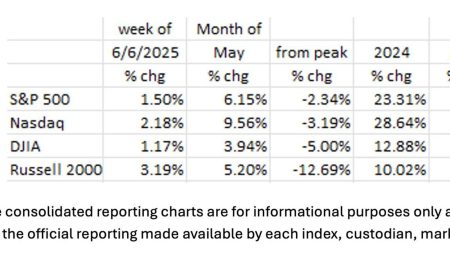Harnessing the Power of Monthly Dividends: A Contrarian Approach to Income Investing
While the allure of quarterly dividends is undeniable, the consistency and predictability of monthly income streams hold a particular appeal, especially for retirees or those seeking a steady cash flow aligned with their expenses. Monthly dividend stocks offer the advantage of aligning payouts with recurring bills, simplifying financial management and providing a sense of stability. This approach is particularly relevant in today’s market, where prevailing fear among traditional investors has created opportunities to acquire undervalued monthly dividend payers at attractive prices. Contrarian investors, known for capitalizing on market downturns, recognize the potential of these overlooked gems. However, it’s crucial to distinguish between high yields and high quality. Simply paying monthly doesn’t guarantee a sound investment. A thorough analysis of underlying fundamentals is essential to avoid "rug-pulls" and ensure long-term sustainability of income.
Navigating the Landscape of High-Yield Monthly Dividend Stocks and Funds
Several sectors offer compelling monthly dividend opportunities, each with its own set of risks and rewards. Real Estate Investment Trusts (REITs), particularly those focused on experiential properties, present an interesting case. EPR Properties (EPR), with its portfolio of theaters, ski resorts, and entertainment venues, stands to benefit from the resurgence in leisure activities post-pandemic. While the company faced challenges during the COVID-19 era, its recovery trajectory and attractive valuation, coupled with a 7.2% monthly dividend yield, warrant consideration. Mortgage REITs (mREITs), such as Ellington Financial (EFC), offer even higher yields, exceeding 12% in some cases. However, their complex investment strategies and reliance on leveraged portfolios require careful scrutiny. EFC’s dynamic allocation across various credit instruments, including residential and commercial mortgages, offers diversification but also introduces potential volatility. Its history of dividend cuts underscores the importance of assessing long-term sustainability.
Exploring Closed-End Funds (CEFs) for Enhanced Income Potential
CEFs represent another avenue for accessing high monthly income, often through specialized investment strategies. PIMCO High Income Fund (PHK), managed by a renowned fixed-income specialist, utilizes a flexible approach across various debt instruments. Its long-term performance history is impressive, but investors must be mindful of the fund’s premium to Net Asset Value (NAV) and potential price fluctuations. Abrdn Income Credit Strategies Fund (ACP) offers an even higher yield, exceeding 15%, by focusing on global corporate junk bonds. However, its concentration in lower-rated debt and recent distribution cut signal higher risk and the need for careful due diligence.
Tax-Advantaged Income with Municipal Bond Funds
For investors seeking tax-efficient income, municipal bond funds offer a compelling option. Nuveen Municipal Credit Opportunities Fund (NMCO) provides a 7.6% monthly dividend yield, which translates to a significantly higher tax-equivalent yield for those in higher tax brackets. While generally considered safer than corporate bonds, NMCO’s focus on lower-rated municipals introduces some credit risk, mitigated somewhat by Nuveen’s extensive experience and resources in the municipal bond market.
Key Considerations for Evaluating Monthly Dividend Investments
Investing in monthly dividend payers requires a nuanced approach, balancing the allure of high yields with the imperative of long-term sustainability and capital preservation. Several factors warrant careful consideration:
-
Dividend Coverage Ratio: This metric indicates a company’s ability to maintain its dividend payout based on its earnings. A higher ratio suggests greater stability and lower risk of dividend cuts.
-
Financial Health: Assess the company’s balance sheet strength, debt levels, and profitability to gauge its overall financial health and resilience in challenging economic conditions.
-
Industry Outlook: Understand the dynamics of the industry in which the company operates. Factors such as regulatory changes, competition, and technological disruption can significantly impact future performance and dividend sustainability.
-
Management Quality: Evaluate the experience and track record of the management team. Prudent capital allocation, strategic decision-making, and a commitment to shareholder value are crucial for long-term success.
- Valuation: Consider the stock’s price relative to its earnings, book value, and other relevant metrics. Investing in undervalued companies provides a margin of safety and enhances the potential for long-term capital appreciation.
Conclusion: A Prudent Approach to Monthly Income Investing
Monthly dividend stocks and funds offer a compelling avenue for generating consistent income, but they require careful selection and ongoing monitoring. A thorough analysis of underlying fundamentals, coupled with an understanding of industry dynamics and management quality, is essential for identifying sustainable high-yield opportunities. By adopting a contrarian mindset and focusing on undervalued companies with strong dividend coverage and sound financial health, investors can build a portfolio that delivers both income and long-term capital growth. Remember, the frequency of dividend payments is less important than the sustainability and quality of the underlying investment. A well-diversified portfolio of carefully selected monthly dividend payers can provide a steady stream of income, contributing to financial stability and long-term wealth creation.










